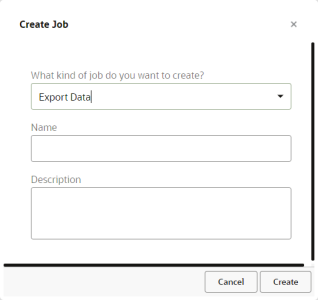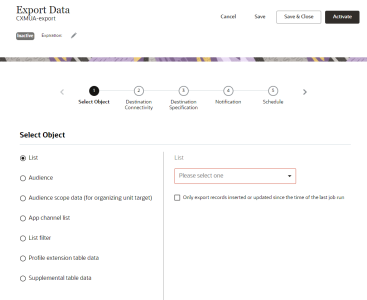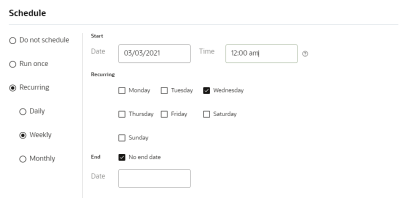Exporting Data
Important: This topic is for users of the latest version of Connect . If your account still uses Classic Connect, download the Classic Connect User Guide.
Learn more by watching the video!
Using Connect, you can export the following types of data sources from Oracle Responsys:
- List
- Audience
- App channel list
- List filter
- Profile extension table data
- Supplemental table data
To create an Export Data job:
- Click
 Data on the side navigation bar, and select Connect.
Data on the side navigation bar, and select Connect. - Click Create Job on the Manage Connect page.
- Select Export Data from the drop-down list and provide a name and description of the export job.
A job name cannot be longer than 100 characters and can include only the following characters: A-Z a-z 0-9 space ! - = @ _ [ ] { }
- Click Done.
The Connect export wizard opens. You may complete the steps in any order, and can save your changes and continue at a later time.
- Complete the steps:
- After configuring all the steps, click Activate to activate the job.
Important: Before you can save or activate the job, you must either set an expiration date, or set the job to never expire. To set an expiration date, click Edit
 next to Expiration. When the job expires, it is deleted and cannot be recovered. Learn more about managing the expiration date.
next to Expiration. When the job expires, it is deleted and cannot be recovered. Learn more about managing the expiration date.
After you finish:
- After you save your job, you can use the Manage Connect page to manage the job. Learn more about managing jobs.
- When you save your job, Connect may return errors. Click Show Errors to review the errors and quickly jump to the page that needs fixing. You must resolve all errors before you can activate the job.
Step 1: Select Object
In this step, you select the objects to export. You can export any of the following:
- Lists
- Audiences
- App Channel Lists
- List filters or App Channel List filters
- Profile extension table data
- Supplemental table data
To select the object to export:
- On the Select Object step, select the type of object you want to export.
- Select the object to export from the list.
- For profile lists: Choose the List if prompted or if you want to use a different list than the one shown.
- For audiences, app channel lists, and profile extension tables: Select the List to which the data source relates before selecting the data source.
- For list filters, choose the List and the Filter.
- For app channel list filters, first select the List filter object. Next, choose the List and select the Use App Channel List. Then choose the Filter.
- Optionally, for lists and tables, you can restrict records to those modified since the last job run (based on the timestamp of your last job run). To do this, select Only export records inserted or updated since the time of the last job run.
Step 2: Destination Connectivity
In this step, you specify where to send the export file. You can export to the Responsys file server or to an SSH File Transfer Protocol (SFTP) server. You can send the export file to up to 3 locations
Use the following to help complete this step:
- Responsys File Server
By default, Connect imports data via your Responsys SCP (Secure Copy Protocol) account file server. This account includes three directories: upload, download, and archive. You can choose the directory to place files in.
IMPORTANT: If not already established, Oracle Responsys Support and your IT team will need to work together to generate an SSH-2 public/private key pair. This ensures secure access to your SCP account via an SSH/SCP client. You may also create your own directories using an SSH (Secure Shell) client.
- External server by SFTP
If you select this option, provide the following information:
- Hostname: Select the hostname from the drop-down list.
- Directory Path: Enter the pathname of the associated directory.
- Username: Enter the username for accessing your SFTP connection.
- Authentication: Depending on the way your server is set up, select either Password or Key.
If this is your first job using key authorization, click Access or Generate Key Information, and enter the email address to receive the public key and instructions for adding the key to your SFTP account. After installing the public key, click Test Connection to confirm that your SFTP connection configuration is valid.
TIP: For information about key authentication, see Selecting, Importing or Generating Public Keys.
Step 3: Destination Specification
In this step, you specify settings for the destination file.
- File to be created: The full name and file extension of the file to create. You can add the file creation date as a prefix and/or suffix. To do this, select a date format from the Prefix or Suffix list.
When the file is created, the jobID and executionID are automatically added as a prefix to the file name. This means that you must include the jobID and execution ID when referring to the file.
- Character set: The character set of the file.
- Field delimiter: The delimiter that divides the fields (columns) in the file.
- Field enclosure: Specify whether text columns and values are enclosed in single or double quotation marks.
Note: For accounts configured to do so, the system will replace delimiters with spaces in all text fields of exported event feed data when NONE is chosen as the enclosing character. For example, if you set up an export event feed data job using a Responsys account configured for this behavior, and then choose NONE as the field enclosure and the tab character as the field delimiter, Responsys will replace all tab characters within text fields with spaces.
- Insert column header as first line: Select this checkbox if the first line in the file contains field names.
- Encryption/compression: Select whether to compress your job as a .ZIP or .GZ file and/or to encrypt it. If you choose the option to compress and encrypt the file with PGP/GPG key, click the Select or import key button to select one or more public keys from the list or import a new public key.
- Insert column header as first line: Select this checkbox if the first line of the exported file contains column headers.
- Additional ready file at completion of download: A ready file is used for validation after the file is exported.
- Select Create empty file to validate the completion of your download process.
- Select Create file with record count to compare simple record counts to verify that all expected record counts were transferred.
For either option, the ready file will have the same name as your export job.
Step 4: Notification
In this step, you specify whether to send email notifications about successful or failed jobs.
Step 5: Schedule
In this step, you schedule the job. The job can run once on a specified date and time, or on a recurring schedule. To run the job on demand, use the Do not schedule option.
IMPORTANT: To ensure that leap years and months with 31 days do not cause issues, you cannot schedule a recurring monthly run on the 29th, 30th or 31st day of a month. You can schedule the job to run on a day of the week that is the last in the month, for example the last Friday of the month.
When setting the start time of a job, select one of four time slots within the hour: 0-14, 15-29, 30-44, 45-59. For each scheduled job, the system picks a random minute (for example, 12 within the 0-14 segment). This distributes the start times of jobs more evenly.
The job will start at random times within the chosen time slot. If you try to set up a new job in a slot that overlaps with the current time, an error message may be issued that states that the time selected occurs in the past. Therefore, as best practice, choose the time slot that is after the current time slot.



